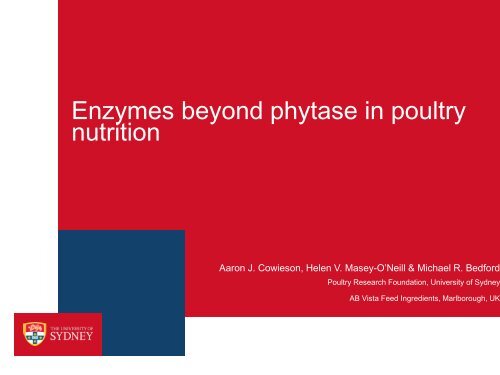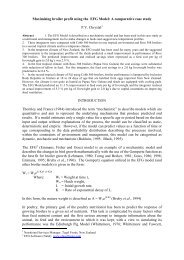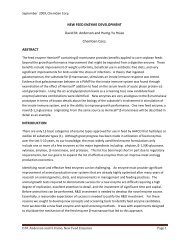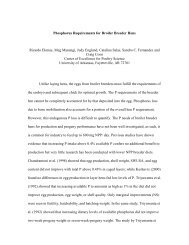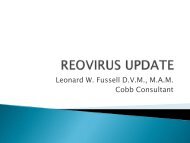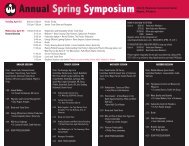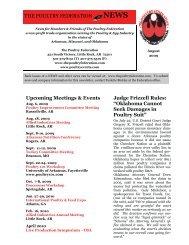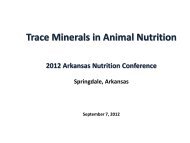PowerPoint-Aaron Cowieson - The Poultry Federation
PowerPoint-Aaron Cowieson - The Poultry Federation
PowerPoint-Aaron Cowieson - The Poultry Federation
- No tags were found...
You also want an ePaper? Increase the reach of your titles
YUMPU automatically turns print PDFs into web optimized ePapers that Google loves.
Enzymes beyond phytase in poultrynutrition<strong>Aaron</strong> J. <strong>Cowieson</strong>, Helen V. Masey-O’Neill & Michael R. Bedford<strong>Poultry</strong> Research Foundation, University of SydneyAB Vista Feed Ingredients, Marlborough, UK
Dr. George W. Hervey (Rutgers, NJAES)becomes the first* to publish a paper on thepotential of feed enzymes to improveperformance and digestibility in poultry!And if all that is not enough!3.532.52Weight gain to20 weeks (lbs)FCRHervey, G.W. (1925) A nutritional study upon a fungus enzyme. Science, 62: 247.*Clickner, F.H. & Follwell, E.H. (1926) Application of Protozyme (Aspergillus orizae) to poultry feeding. <strong>Poultry</strong> Science, 5: 241-247.3
What if all feed enzymes were FREE?What would you use if you had access to all enzymes free of charge?› Simply adding every conceivable product would likely result indeterioration of performance vs. an enzyme-free control diet› Kick phytase dose up until performance maxed out then addin something else? Xylanase? Protease?› Worth asking yourself this question! Maybe we will answer itby the end of this presentation.....5
Chronological effectsEnzyme (especially non-phytase) efficacy declined from 1980-2010?› Rosen (2002) suggests that non-phytase bioefficacy declined over timefrom the 1980s to early 2000s predicting that if the trend continued ZEROeffect would be reached in 2004› This did not happen› Whats going on?6
De Beer (2010)
Projected Progress02010 2011 2012 2013 2014 2015 2016 2017 2018 2019 2020-0.05-0.1-0.15-0.2-0.25NutritionGenetic progress-0.3-0.35-0.4
FCR in the Future1.61.51.4FCR1.31.21.1FCR = 1.212010 2011 2012 2013 2014 2015 2016 2017 2018 2019 2020Year
Where does the genetic improvement come from?› Largely from increased feed intake and decrease maintenancerequirements (Huang, 2012; de Beer, 2012 – personal comm.)› HOWEVER, McDevitt et al. (2006) found that selection from 1970 to 2000has increased (P
So what?› Genetics have altered the birds efficiency, partly by altering nutrientdigestibility.› Simultaneously cereal and grain legume varieties are nutritionallyenhanced› Husbandry, nutrition and biosecurity is improved since 1970s› <strong>The</strong> closer bird performance is to the genetic potential the less opportunitythere is for enzyme to elicit a beneficial effect.› Nutrient digestibility cannot exceed 100%.› A CONCEPTUAL FRAMEWORK TO UNDERSTAND THE LIMITS11
A caveat!FCR is not fair......!› Today a 2kg may eat 3kg of feed and so return an FCR of 1.5› HOWEVER, the bird is 35% DM and the feed is 88% DM› THUS, the reality is that on a DM basis the above is a 700g (DM) bird eats2.65kg (DM) so the ‘true’ FCR of dry matter intake and dry matter retentionis actually 3.8.› We still have a fair way to go to reach an FCR of 1.0, even on a ‘fresh’basis.› <strong>The</strong> easiest way to achieve this is to drop the DM content of the live bird.12
Microingredient competitionAn additional challenge to innovation› In addition to a genetic (cereal and bird) backdrop that reduces theopportunity for feed enzymes we have a more competitive environment› Pro-biotics, pre-biotics, organic acids, essential oils, emulsifiers, enzymesetc.› As digestibility coefficients near 100% (especially for the limiting dietarynutrients) and flock potential nears genetic potential there is anincreasingly CANNABALISTIC ENVIRONMENT for microingredients13
Enzyme Response (%)Establishing the limits› Enzyme effect follows a distinct law of diminishingreturn, well correlated with control180160140Largely restrictedto phytase120100e.g. P80604020e.g. Cae.g. thre.g. met00 5 10 15 20 25 30 35 40 45 50 55 60 65 70 75 80 85 90 95 100Control Digestibility (%)e.g. starch
% improvement in IAAD with xylanaseProtein quality and enzymes605019 peer reviewed studies published between 1998 and 2009where the effect of xylanase on ileal amino acid digestibilitywas reported. ~538 observations. (P
Rule of thumbIn most instances, unless you absolutely know otherwise, it islikely that every new additive you put in your diet will reducethe efficacy of the incumbents on a like for like nutrient basis,perhaps by as much as 30%.16
Beyond phytase.......What is left to go for?SOME BALLPARK FIGURES› 0.05-0.10% digestible P› 0.30-0.50% digestible Ca (what value does this offer?)› 0.10-0.15% digestible SAA› 0.15-0.20% digestible LYS› 0.20-0.25% digestible THR› 1200 kcal/kg digestible energy- 850kcal locked up in lignified cellulose, AX and pectin-type fibre- 350kcal locked up in undigested starch, protein and fat- 130kcal starch, 120kcal protein, 90kcal fat17
Beyond phytase (cont.)Where does all that potential come from?› Undigested P is largely from incomplete phytate hydrolysis› Undigested Ca from vegetable and MBM sources, some from lime› Undigested AAs largely from endogenous proteins› Undigested energy largely from fibre and endogenous protein- Perhaps only 200kcal/kg is from undigested DIETARY protein, fat and starch18
Low hanging fruitP first› Little excuse for P digestibility to be substantially less than 100%› Phytases are inexpensive so use more› Next generation phytases can give close to 90% phytate recovery at 1500FTU/kg› Where next for phytase?› Possible combinations of super-dosing with acid phosphatases and/or 3/6combos (Zyla et al., 2004)?19
Total Ca (% as fed)Phytase moves us around on the Ca/P planeNutritional Geometry of Ca and P› BWG 7-28d broilers (g)› Corn/Soy-based diet› Effect of Ca and avP› Av.P P
Total Ca (% as fed)Phytase moves us around on the Ca/P planeNutritional Geometry of Ca and P› FCR 7-28d broilers› Corn/Soy-based diet› Effect of Ca and avP› Av.P P
Total Ca (% as fed)Phytase moves us around on the Ca/P planeNutritional Geometry of Ca and P› Tibia ash 28d broilers (%)› Corn/Soy-based diet› Effect of Ca and avP› Av.P P
Total Ca (% as fed)Phytase moves us around on the Ca/P planeNutritional Geometry of Ca and P› L2L 28d broilers (mins)› Corn/Soy-based diet› Effect of Ca and avP› Av.P P
Total Ca (% as fed)Phytase moves us around on the Ca/P planeNutritional Geometry of Ca and P› AICND 28d broilers› Corn/Soy-based diet› Effect of Ca and avP› Av.P P
Total Ca (% as fed)Phytase moves us around on the Ca/P planeNutritional Geometry of Ca and P› AICNaD 28d broilers› Corn/Soy-based diet› Effect of Ca and avP› Av.P P
A note on phytate› Differential scanning calorimetry and vapour pressure osmometry used toexplore the interaction between protein and phytate› Phytate DOES bind directly to protein provided that the pH is below the pIof the protein› Thus, in the gastric phase of digestion phytate crosslinks protein, droppingout of solution› In the small intestine phytate acts indirectly as a Hoffmeister anion› Importantly, ANIONS displace phytate from the protein surface thus thoughmuch has been made of the putative interacting effects of phytate and Nait may be Cl and other anions that are responsibleBye, J.W., <strong>Cowieson</strong>, N.P., Scwarz, R.R., <strong>Cowieson</strong>, A.J., Selle, P.H. & Falconer, R.J. (2012) <strong>The</strong> dual effects ofsodium phytate on the structural stability and solubility of proteins. Journal of Biological Chemistry, Under Review.26
Medium hanging fruit› If the low hanging fruit is higher phytase doses and/or combinations ofdifferent phytase at conventional doses what is next?› Xylanase OR glucanase (<strong>Cowieson</strong> et al., 2010)- Enhanced protein digestibility (gives some energy release)- Variable improvements in fat and starch digestibility- Marginal P and Ca digestibility improvements› New mechanisms for xylanase emerging (Masey-O’Neill et al., 2012;<strong>Cowieson</strong> & Masey-O’Neill, 2012) that explain the ‘generic effects’(<strong>Cowieson</strong> & Bedford, 2009) on all nutrients27
IDE (kcal/kg)CAIND<strong>Cowieson</strong> & Masey-O’Neill (2012) Under ReviewXylanase* addition to a wheat-based diet 1-49d in broilers340033503300325032003150310030503000AID d28AID d490.90.890.88› Xylanase effects for N andDE P
d49 BW (g/bird)FCR d49 (g:g)<strong>Cowieson</strong> & Masey-O’Neill (2012) Under ReviewXylanase addition to a wheat-based diet 1-49d in broilers415041004050› Xylanase effects P
Caecal thermogenesis30
<strong>Cowieson</strong> & Masey-O’Neill (2012) Under ReviewXylanase addition to a wheat-based diet 1-49d in broilers37.53736.53635.535Caecal Temp (ºC)› Xylanase effects P0.05) effect on headtemperature› Caecal microclimate› Higher temp with xylanase› Ruminants/fermentation31
Xylanase“medium hanging fruit”› Reasonably consistent, especially in diets with a proportion of wheat orequivalent› Effects cumulative and exaggerated in the older bird (if fed from day old)› Displacing fat reduces the effectiveness› May act through the caecal microflora, VFA and PYY (ileal brake)› May interact therefore with gastric digestion32
Cooney et al., (1969) Biotech & Bioeng› Fermentation heatproduction is dependent onmicrobial species andsubstrate availability› Higher heat, more complexsubstrate› Higher heat,Bacillus>E.coli>Asp>Clost› NB (metabolic heat)- Rumen 7%- Caeca 0.2%33
Ok, high phytase doses, plus xylanase, what else?Whats left?› Realistically the use of 1000FtU/kg phytase and an aggressive xylanaseleaves little ‘meaningful’ undigested nutrients behind› Some room to capture additional Lys, Thr and potential for Val, Ile, Gly,Ser, Arg (may be able to drop SBM inclusion if done carefully)› Little additional energy or P potential› “high hanging fruit”- Pectin, amorphous cellulose degradation.- Proteases (more data today than ever before but may be inconsistent)- Driven by high SBM prices, definitely worth exploration- Cystine peptidases and aspartic acid peptidases34
Future› Genetic improvements likely to drop FCR for a 2kg bird to 1.20 by 2020-2025› More microingredient launches and so more competition› Though digestibility coefficients approach 100% there is room forintervention in NUTRIENT REQUIREMENT and MAINTENANCE› Can enzymes increase water retention?› Can enzymes reduce viscera mass?› Net effects? Net energy etc?35
Conclusions› Global feed additive market to grow from $13.5bn in 2010 to $17.5bn in2018› Digestibility coefficients are difficult to improve beyond 0.95.› FEED COST savings with enzymes may max out around $20/tonne- Many paths, but not all paths, will get you there!› Very few genuine paradigm shifts in the feed enzyme market sincephytase was launched in the early 1990s, perhaps due to law ofdiminishing returns.› I wonder what Dr. George Hervey would make of his humble Leghornexperiment having led to an international market worth in excess of $650mUSD! He’s not even mentioned on Rutgers ‘historical achievements’ list!36


